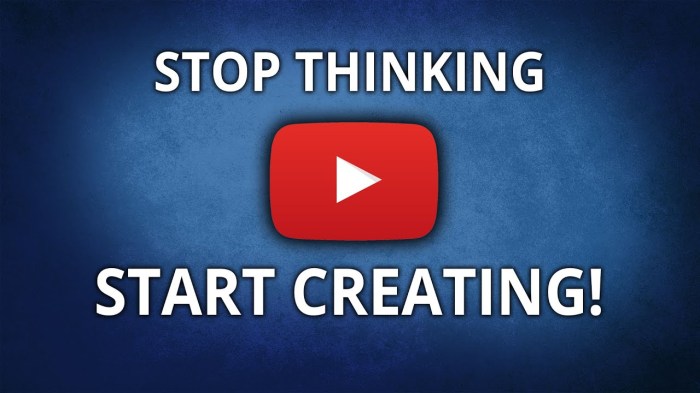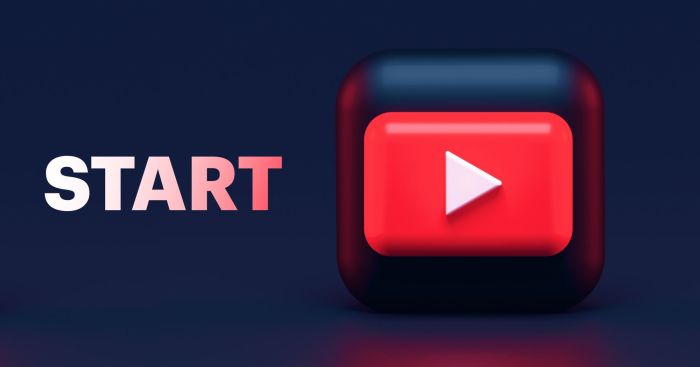Starting a YouTube Channel opens the door to a world of creativity, connection, and endless possibilities. Dive into this guide filled with tips and tricks to kickstart your channel with style.
From defining what a YouTube channel is to monetizing your content, this journey will equip you with the tools to thrive in the digital realm.
Understanding the Basics: Starting A YouTube Channel
A YouTube channel is a platform on YouTube where creators can upload, share, and organize their videos for viewers to watch.
Starting a YouTube channel comes with various benefits, such as:
Benefits of Starting a YouTube Channel
- Creating a platform to showcase your creativity and talents.
- Building a community of followers and engaging with them through comments and feedback.
- Monetizing your channel through ads, sponsorships, and merchandise.
- Increasing your online presence and personal brand.
Potential Audience Reach and Impact
YouTube has a massive audience, with billions of users watching videos every day. By starting a YouTube channel, you have the potential to reach a global audience and make a significant impact on viewers worldwide.
Planning Your Content

When starting a YouTube channel, planning your content is crucial to attract and retain viewers. It involves deciding on the type of content you want to create, choosing a niche, and creating a content calendar for consistent uploads.
Different Types of Content for a YouTube Channel
- Vlogs: Share your daily life, experiences, and thoughts.
- Tutorials: Teach your audience how to do something.
- Product Reviews: Give your opinion on various products.
- Challenges: Engage with your audience through fun challenges.
- Travel Videos: Showcase your travel adventures and experiences.
Tips on Choosing a Niche for Your Channel
- Focus on your passion: Choose a niche that you are genuinely interested in.
- Research your target audience: Understand what content your potential viewers are looking for.
- Be unique: Find a unique angle or perspective to stand out in a crowded niche.
- Consider your expertise: Select a niche where you have knowledge or experience to share.
The Importance of Creating a Content Calendar
A content calendar helps you stay organized and consistent with your uploads. It allows you to plan ahead, maintain a regular posting schedule, and ensure that your content aligns with your overall goals and strategy.
Setting Up Your Channel
Creating a YouTube channel is a crucial step in starting your journey as a content creator. Follow these steps to set up your channel and make it appealing to your audience.
Creating Your YouTube Channel
- Sign in to your Google account and go to YouTube.
- Click on your profile icon and select “Your Channel” from the drop-down menu.
- Click on “Create Channel” and choose to create a personal or business channel.
- Follow the prompts to customize your channel name and verify your account.
Customizing Your Channel Branding
- Upload a high-quality profile picture that represents your channel or brand.
- Create a visually appealing banner that reflects the content of your channel.
- Use consistent colors and fonts to maintain a cohesive branding across your channel.
Crafting an Engaging Channel Description
Having an engaging channel description is essential to attract viewers and give them a glimpse of what to expect from your content.
- Introduce yourself or your brand in a concise and captivating way.
- Highlight the type of content you will be creating and what makes your channel unique.
- Incorporate relevant s to improve searchability and attract your target audience.
Creating High-Quality Videos

Creating high-quality videos is essential to engaging your audience and growing your YouTube channel. From filming techniques to editing software, every aspect plays a crucial role in producing top-notch content. Let’s dive into some key tips and strategies to elevate the quality of your videos.
Filming Techniques and Equipment
- Invest in a good camera: A high-quality camera can make a significant difference in the overall look of your videos. Consider cameras with good resolution and low-light performance.
- Use proper lighting: Lighting can make or break your video quality. Invest in softbox lights or LED panels to ensure your videos are well-lit and visually appealing.
- Focus on composition: Pay attention to framing, rule of thirds, and symmetry to create visually pleasing shots. Experiment with different angles and perspectives to keep your audience engaged.
- Utilize a tripod or stabilizer: Avoid shaky footage by using a tripod or stabilizer to keep your shots steady and professional-looking.
Importance of Good Audio Quality
- Invest in a quality microphone: Good audio quality is just as important as video quality. Consider using a lavalier microphone or a shotgun microphone to capture clear and crisp audio.
- Avoid background noise: Find a quiet space to film and consider using soundproofing materials to reduce background noise and distractions.
- Adjust audio levels: Make sure your audio levels are balanced and consistent throughout your videos. Use audio editing software to enhance sound quality if needed.
Editing Videos Effectively
- Choose the right editing software: There are many editing software options available, such as Adobe Premiere Pro, Final Cut Pro, or even free options like DaVinci Resolve. Find one that suits your needs and skill level.
- Cut out unnecessary footage: Trim down your videos to keep them concise and engaging. Remove any pauses, mistakes, or irrelevant content to maintain viewer interest.
- Add transitions and effects: Enhance your videos with transitions, text overlays, music, and other effects to make them more dynamic and visually appealing.
- Color correction and grading: Use color correction tools to adjust the color and lighting of your videos for a more professional look. Experiment with different color grading techniques to create a unique visual style.
Growing Your Audience
To expand your audience on YouTube, it’s crucial to promote your videos and channel effectively. Engaging with your viewers through comments and messages can also help build a loyal following. Collaborating with other YouTubers is another great way to reach new audiences and grow your channel.
Promoting Your Videos
- Share your videos on social media platforms like Instagram, Twitter, and Facebook to reach a wider audience.
- Utilize strategies by using relevant s in your video titles, descriptions, and tags to improve visibility on YouTube.
- Consider running ads on YouTube to reach a targeted audience and increase your video views.
Engaging with Your Audience, Starting a YouTube Channel
- Respond to comments on your videos to show appreciation for your viewers and encourage interaction.
- Ask your audience questions in your videos to prompt engagement and create a sense of community.
- Host live streams or Q&A sessions to directly interact with your audience and build a stronger connection.
Collaborating with Other YouTubers
- Reach out to other YouTubers in your niche to collaborate on videos and cross-promote each other’s channels.
- Participate in collab challenges or series to introduce your channel to a new audience and gain exposure.
- Feature other YouTubers on your channel and vice versa to create engaging content that appeals to both of your audiences.
Monetizing Your Channel
To start making money from your YouTube channel, you need to explore various monetization options available to creators. Let’s dive into the different ways you can generate revenue and maximize your earnings.
YouTube Partner Program Requirements
To join the YouTube Partner Program and start earning money from ads on your videos, you need to meet the following requirements:
- Have at least 1,000 subscribers on your channel.
- Reach 4,000 watch hours in the past 12 months.
- Comply with all YouTube policies and guidelines.
Maximizing Revenue Opportunities
Once you are eligible to monetize your channel, consider these tips to maximize your revenue potential:
- Ads: Enable different types of ads on your videos, such as display ads, overlay ads, skippable video ads, and non-skippable video ads, to increase your ad revenue.
- Sponsorships: Collaborate with brands or companies for sponsored content to earn additional income through partnerships and product placements.
- Merchandise: Create and promote your own branded merchandise, such as t-shirts, mugs, or accessories, to engage with your audience and generate revenue through sales.





